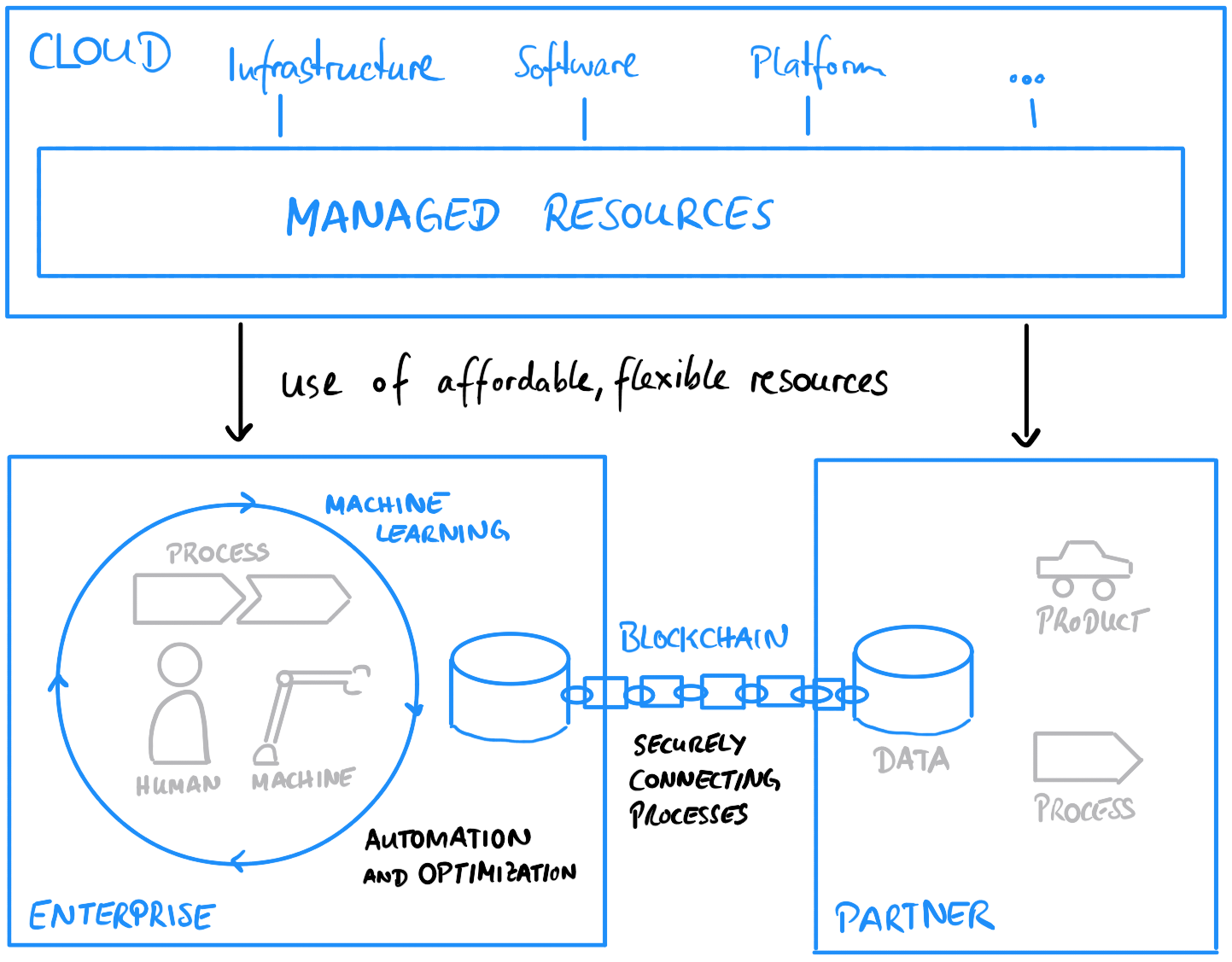Topics
Information technology is developing rapidly. Currently Cloud Computing, Machine Learning and Blockchain are three technologies that have prevailed (Cloud), are in the process of adaption (Machine Learning) and will gain traction in the future (Blockchain.)
Business IT has learned to manage its infrastructure such as clients, servers and networks. It is not a relevant advantage to have the best printers or monitors anymore, however, having the most effective software is essential. For this reason, ERP, CRM and intranet portals have developed to serve a common data basis and to provide the technology to automate business processes. This holds true also for an online shop (e-commerce solution) providing an additional sales channel and allowing to distribute digital assets such as manuals and technical data, but it is still no advantage on the market and considered standard within the industry. The next level of the IT evolution came with the availability of computing power in small form factors as well as the connectivity of these devices with flexible resources online (cloud computing). It is called Industry 4.0 or Industrial Internet of Things and it allows new ways of prediction when combined with the features of machine learning models. Despite its recent success, Industry 4.0 applications still need a business model with managable risks (i.e. cyber security) and automated billing features in order to generate shareholder value for its owners.

Key Technologies
By using affordable and flexible resources online (cloud), for example to train a neural network (machine learning), resources within the corporate IT can be utilized to automate and optimize internal processes. The products resulting from these processes are used outside of the premises of the enterprise, thus a secure connection to the smart products needs to be established (blockchain) to harvest the value of their data in a risk-averse way.
Cloud Computing
Simply put, cloud computing is providing resources over the Internet. Besides providing computing power (Infrastructure as a Service, IaaS) other examples include using managed servers or application platforms (Platform as a Service, PaaS) or even consuming entire software applications with a user interface (Software as a Service, SaaS) on demand. The question whether one should use only cloud or only on-premises systems has been answered by the cloud computing industry with various forms of hybrid cloud computing which allows for a combination of the two. The further an organization is on its cloud journey, the more cloud providers it has encountered. Using more than one cloud provider at once is often referred to as multi-cloud.
An IT strategy without cloud components only seems sensible for very few organizations, for example in the defense industry, military or for critical infrastructures. The advantages are obvious: Flexibility to select and pay only for those resources required for the job, cost effective through extremely low prices driven by fierce competiton amoung cloud service providers and the sheer velocity provisioning new systems in seconds. Disadvantages such as long contracts, vendor lock-in and support level agreements do not outweight the opportunities of cloud computing. Despite this seemingly clear picture, every system and process has to be evaluated for possible advantages, risks and drawbacks to make an active decision for or against cloud use.
Machine Learning
Lowering the cost and size of CPU power allowing Industry 4.0 applications can be transferred in a similar way to graphic processing units (CPU) allowing to execute and train large machine learning models for an affordable price. In combination with cloud computing where models are usually trained, IIoT (Instrustrial Internet of Things) devices can execute these models to automate human tasks, for example inspecting the surface quality of a product for damages and classifying the damange to be resolved quickly. Finally, processes will become more objective, faster and more automated applying pattern recognition, predictive analysis and self-learning systems.
Blockchain
Still the Blockchain technology lags far behind the conceived expectations. A distributed, forgery-proof database with automation capabilities (Smart Contracts) solely solves a particular class of problems such as a secure transactions without a broker, however, it will not supersede the currencies of all central banks. Still I am convinced that a network (e.g. a supply chain) without a central broker, but with strong encryption and automatically enforced rules - known as Permissioned Enterprise Blockchain - enables new collaborative business models. The sketch above can be explained by an example from manufacturing: An IIoT device measures the flow of coolant which provides a cooling effect to the machining process. The measured result, in the example the cooling effect, automatically creates a claim towards the manufacturer. This output-oriented business model (pay for the effect, not the product) is spreading, because the advantage to pay for results rather than products allows to scale up and down with less impact on fixed costs and bound capital. On the downside, this business model impacts the network load and it leads to complex contractual agreements as well as higher transparency of the production setup for the suppliers. The logic consequence is a consolidation on the market and in technology to an architecture where a nearby server executes a Smart Contract and writes the result to a central Ledger. This way only the result is transmitted securely, not single measurements resulting in a balance between transparency and automation between the supplier and the manufacturer. Together with machine learning and cloud computing the blockchain technology offers the ability to monetize digital business models even for small and mid-sized enterprises.